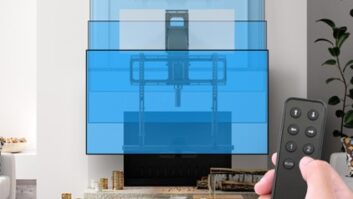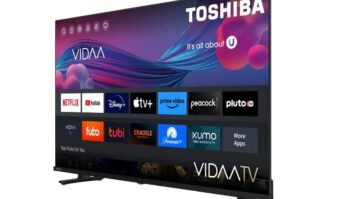NEW YORK —
With Toshiba’s IT and consumer
electronics divisions now under one roof, the company
is moving ahead to develop a fully integrated
product offering that encompasses the two categories.
Jeff Barney, VP and GM of Toshiba’s digital products
division, who now heads the combined unit,
told TWICE in an interview just prior to International
CES that the company will take advantage of these
newly created synergies on several fronts. This will
include introducing certain PC products to its TV
retail customer base, adding computing power to its
televisions, and deepening its TV product assortment
with its established retailers.
On the IT side this year Toshiba will introduce its
first tablet PC and enter the all-in-one (AIO) computer
market.
The merger of the two divisions was announced
last May and the process of merging them began
on July 1 when Toshiba’s consumer electronics
arm, Toshiba America Consumer Products, officially
combined with the company’s IT segment, Toshiba
America Information Systems.
This move was essentially completed by October,
but the larger and more complicated project of creating
a unified retail product presentation is now underway,
Barney said.
The culmination of these machinations will be to
deliver a fully integrated television and computing experience where the end user will be able to move
content between devices.
However, Barney said Toshiba is committed to its
established retailers.
“The goal for 2011 is to grow the TV business. We
will not bring on new [retail] partners, but go deeper
with who we have,” Barney said, adding Toshiba
does not want to endanger its relationship with its
customers by rapidly expanding and losing the ability
to execute well and remain on intimate terms with
the dealers.
The goal is to build up sales on the TV side to the
same level as the PC business. Currently, Toshiba’s
IT segment sales are about three times larger than
what televisions deliver, Barney said.
Toshiba’s IT infrastructure, including marketing
and public relations are more mature, Barney said,
and this strength will be leveraged to help boost the
company’s TV presence.
However, the company does not intend to stop
there. In addition to deepening its retail TV offering,
the company plans to make its just-announced AIO
computer available for specialty retailer and custominstallation
dealers.
“Putting the two together makes a lot of sense,”
he said, and this is part of the company’s plan to
eventually offer a fully integrated product set that
will include computers, tablet PCs and televisions.
The AIOs will ship sometime in 2011 and are intended
to replace the PC tower as a home’s primary
computer. Toshiba entered the AIO market in Japan
about a year ago, Barney said.
Tying everything together will be the company’s
tablet PC. While tablets are initially being viewed as
a consumer consumption device, its long-term prospects
are huge, Barney said.
“We believe the tablet design is as important to us
as the clamshell laptop was 25 years ago,” he said.
Barney said the tablet market has the potential to
hit 20 million in 2011 and double again just a few
years later.
Toshiba’s first tablet is the lead device of what will
be a family of products that will include other screen
sizes and usage models. The initial offering has a
10.1-inch display an Nvidia processor and is based
on the Android operating system. It will be priced
similarly to the iPad.
The operating system is extremely important, Barney
said, as Toshiba sees Android as the backbone
of its future integrated home system.
“The Android OS is the core. People are already
familiar with it and there are apps available,” he said.
Toshiba is now working on cross-platform delivery
software so content can be easily shared between
its TVs, tablets and computers.
The television will not be left out of this revolution as
Toshiba sees it evolving from a simple Internet-connected
device to having built-in computing capability with hard drives and a processor.
“We are committed to bringing computing power
to the TV,” Barney said.
This transition will not take place until Toshiba can
deliver such a product that has the same performance
characteristics as a conventional TV. In addition,
the economic model has to be correct and the
consumer must be ready to accept a truly smart TV.
“This [development] cannot hurt the TV experience
as people now know it,” he said, adding most
people would not put up with a computer-like experience
with their TV.













